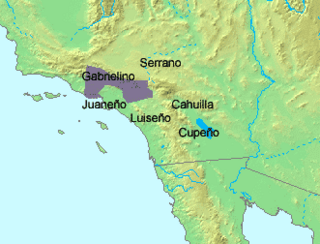Tongva language
| Tongva | |
|---|---|
| Gabrielino-Fernandeño | |
| Native to | USA |
| Region | Southern California |
| Extinct | 1970s? (revitalization 2004) |
Uto-Aztecan
| |
| Language codes | |
| ISO 639-3 | xgf |
xgf | |
 | |
The Tongva language (also known as Gabrielino or Gabrieleño) is a Uto-Aztecan language formerly spoken by the Tongva, a Native American people who live in and around Los Angeles, California. Tongva is closely related to several other Takic languages, including Cahuilla and Serrano.
The last fluent native speakers of Tongva lived in the early 20th century, but no evidence to this time and date can prove a fluent speaker in the last 150 years.[clarification needed] The language is primarily documented in the unpublished field notes of John Peabody Harrington made during that time. The "J.P. Harrington Project", developed by the Smithsonian through UC Davis, his notes of the Tongva language, approximately 6,000 pages were coded for documentation by a Tongva member who took 3 years to accomplish.
There are claims of native speakers of Tongva who have died as late as in the 1970s, but there is no independent verification of these individuals having been fluent speakers.
Evidence of the language also survices in modern toponymy of Southern California, including Pacoima, Tujunga, Topanga, Azusa, Cahuenga in Cahuenga Pass, and Cucamonga in Rancho Cucamonga.
Language revitalization
As of 2012, members of the contemporary Tongva (Gabrieleño) tribal council are attempting to revive the language, by making use of written vocabularies, by comparison to better attested members of the Takic group to which Tongva belonged,[1] and by offering classes.[2] [3]
Phonology
Consonants
The following is a list of the consonants of the Tongva language. In parenthesis is the spelling of the specific sound. Note that there are multiple orthographies for the Tongva language and certain letters represent more than one sound therefore certain sounds may have multiple ways to be spelled.
| Bilabial | Labio- dental |
Alveolar | Post- alveolar |
Palatal | Velar | Uvular | Glottal | ||
|---|---|---|---|---|---|---|---|---|---|
| Nasal | m (m) | ɱ (m) | n (n) | ŋ (ng~n) | |||||
| Plosive | voiceless | p (p) | t (t) | k (k~c~qu) | (ʔ) | ||||
| voiced | b (b) | d (d) | ɡ (g~gu) | ||||||
| Fricative | voiceless | ɸ (p) | f (p~v~f) | s (s) | ʃ (sh~ch) | ç (h~r) | x ~ χ (h~g) | ||
| voiced | β (b) | v (v~w) | z (z) | ʒ (x~sh~ch) | ʝ (y~x~j) | ɣ (x~h) | ʁ (r) | ɦ (h) | |
| Trill | r (r) | ||||||||
| Approximant | ʋ-ʍ (w) | l (l) | j (y~j) | ||||||
Morphology
Tongva is an agglutinative language, where words use suffixes and multiple morphemes for a variety of purposes.
Vocabulary
The Lord's Prayer[4]
The Lord's Prayer is called 'Eyoonak in Tongva. The following text was derived from old Mission records.
'Eyoonak
'Eyoonak, 'eyooken tokuupanga'e xaa;
hoyuuykoy motwaanyan;
moxariin mokiimen tokuupra;
maay mo'wiishme meyii 'ooxor 'eyaa tokuupar.Hamaare, 'eyoone' maxaare' 'wee taamet,
koy 'oovonre' 'eyoomamaayntar momoohaysh, miyii 'eyaare
'oovonax 'eyoohiino 'eyooyha';
koy xaare' maayn 'iitam momoohaysh,
koy xaa mohuu'esh.
'Wee menee' xaa'e.
Collected by C. Hart Merriam (1903)[5]
(Merriam refers to them as the Tongvā)
- Numbers
- Po-koo /bo'kʰøː/
- Wěh-hā /ʋɛj'χɒː/
- Pah-hā /pa'χɒː/
- Wah-chah /ʋa'ʃɒχ/
- Mah-har /ma'χɒʁ/
- Pah-vah-hā /pa'va'χɒː/
- Wah-chah-kav-e-ah /ʋa'ʃa'kʰav̥eʲa/
- Wa-ha's-wah-chah /ʋa'χz̥ʷaʃa/
- Mah-ha'hr-kav-e-ah /ma'χaɣ̥ʁ'kʰav̥eʲa/
- Wa-hās-mah-hah'r /ʋa'χɑz'ma'χaɣ̥ʁ/
- Wa-hā's-mah-hah'r-koi-po-koo /ʋa'χɑz'ma'χaɣ̥ʁ' kʰoi'bokʰu/
- Wa-hā's-mah-hah'r-koi-wěh-hā /ʋa'χɑz'ma'χaɣ̥ʁ' kʰoi'ʋɛj'χɒː/
- grizzly bear
- hoó-nahr /χœ'naʁ/
- hoon-nah /χun'na/ (subject)
- hoon-rah /χun'ra/ (object)
- black bear
- pí-yah-hó-naht /pija'χø'natʰ/
Collected by Alexander Taylor (1860)[5]
- Numbers
- po-koo /po'kʰø/
- wa-hay /ʋa'χai/
- pa-hey /ʋa'χai/
- wat-sa /ʋa'tsa/
- mahar /maχʁ/
- pawahe /paʋaχe/
- wat-sa-kabiya /ʋa'tsa'kʰaβɨjɒː/
- wa-hish-watchsa /ʋa'χɪʃwatsʒz̥ɒː/
- mahar-cabearka /maχar'çaβir'kʰɒː/
- wa-hish-mar /ʋa'χɪʃ'mar'/
Taylor claims "they do not count farther than ten"
- bear
- hoo-nar /χø'nar/
Collected by Dr. Oscar Loew (1875)[5]
- Numbers
- pu-gu' /pu'guʲ/
- ve-he' /vɛ'χɛʲ/
- pa'-hi /pʰa'çi/
- va-tcha' /va'tsʃaʲ/
- maha'r /maχ'aʁ/
- pa-va'he /pʰa'vaʝe/
- vatcha'-kabya' /va'tsʃaʲ kʰabʲɒː/
- vehesh-vatcha' /vɛχɛʃ'va'tsʃaʲ/
- mahar-kabya' /maχ'aʁ'kʰabʲɒː/
- vehes-mahar /vɛχɛs'ma'χar/
- puku-hurura /bukʰy'χurura/
- vehe-hurura /vɛ'χɛ'χurura/
- bear
- unar /œ'nar/
Collected by Charles Wilkes, USN (1838-1842)[5]
- Numbers
- pukū
- wehē
- pāhe
- watsā
- bear
- hundr
Other sources
- desert fox: erow[6]
- Pacoima = from the root word Pako enter, meaning the entrance[citation needed]
- Tujunga = from the root word old woman tux'uu[citation needed]
- Azusa = from the word -shuuk 'Ashuuksanga = his grandmother[citation needed]
Toponymy
The table below gives various place names in the Tongva language, and in Spanish.[4]
| English | Tongva | IPA |
|---|---|---|
| Los Angeles | Yaa | /jɒː/ |
| San Bernardino | Wa'aach | /ʋaj'ɒʃ/ |
| San Gabriel | Shevaa | /sʃe'vɒː/ |
| San Pedro | Chaaw | /ʃɒːʋ/ |
| Santa Ana | Hotuuk | /χo'tʰykʰ/ |
| Santa Monica | Kecheek | /kʰɛʃeɪkʰ/ |
| Santa Catalina | Pemu | /bʰɛmɯ/ |
References
- ^ The Limu Project (active language revitalization)
- ^ Keepers of Indigenous Ways: Tongva Language History & classes
- ^ R. Plesset (2012-06-01). "San Pedro: Science Center Endangered/Tongva Village Site Revitalization". Indymedia Los Angeles. Retrieved 2012-08-26.
- ^ a b Munro, Pamela, et al. Yaara' Shiraaw'ax 'Eyooshiraaw'a. Now You're Speaking Our Language: Gabrielino/Tongva/Fernandeño. Lulu.com: 2008.
- ^ a b c d McCawley, William. The First Angelinos: The Gabrielino Indians of Los Angeles. Malki Museum Press, 1996
- ^ Native Languages of the Americas[year needed]
External links
- The Limu Project (active language revitalization)
- Reconstructed Tongva spoken (streaming video, Tongva speech beginning at 35:10)
- Gabrielino (Tongva) Language, native-languages.org
- Gabrielino language overview at the Survey of California and Other Indian Languages
- Keepers of Indigenous Ways: Tongva Language History & classes
